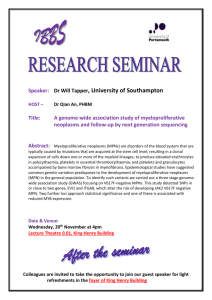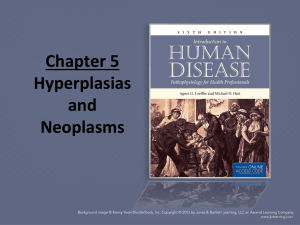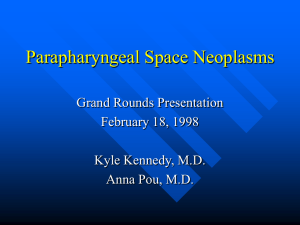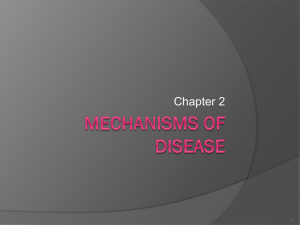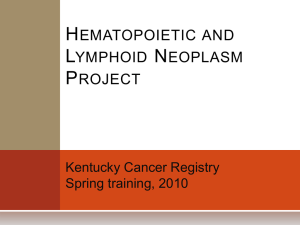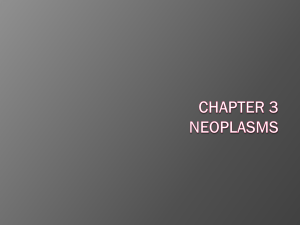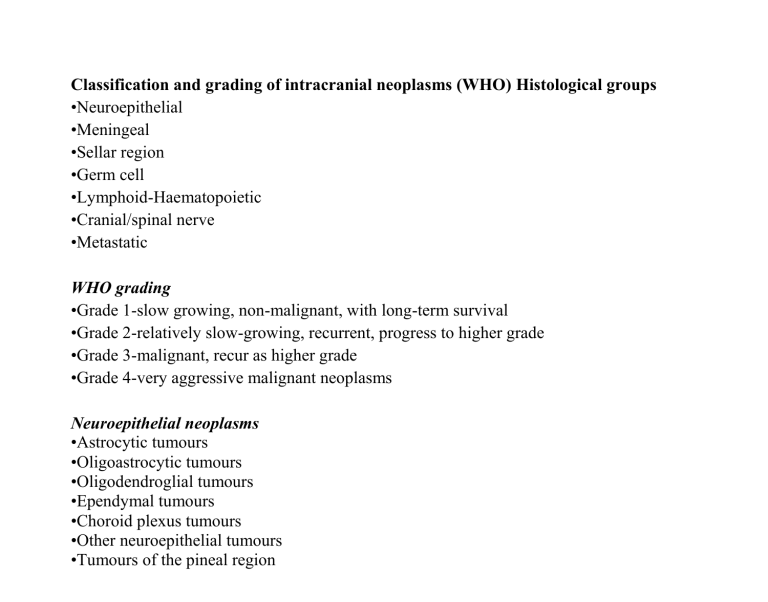
Classification and grading of intracranial neoplasms (WHO) Histological groups •Neuroepithelial •Meningeal •Sellar region •Germ cell •Lymphoid-Haematopoietic •Cranial/spinal nerve •Metastatic WHO grading •Grade 1-slow growing, non-malignant, with long-term survival •Grade 2-relatively slow-growing, recurrent, progress to higher grade •Grade 3-malignant, recur as higher grade •Grade 4-very aggressive malignant neoplasms Neuroepithelial neoplasms •Astrocytic tumours •Oligoastrocytic tumours •Oligodendroglial tumours •Ependymal tumours •Choroid plexus tumours •Other neuroepithelial tumours •Tumours of the pineal region •Embryonal tumours (medulloblastoma, CNS Primitive Neuroectodermal Tumour/PNET, atypical teratoid/rhabdoid tumour) Astrocytic neoplasms Grouped by: •Topography(supratentorial vs. infratentorial) •Differentiation(fibrillary, protoplasmic, gemistocytic) •WHO grade 1-(Pilocytic astrocytoma, chordoid glioma, desmoplastic astrocytoma, pituicytoma), 2-(Well-differentiated-low cellularity/ minimal pleomorphism, no vascular proliferation or necrosis), 3-(Anaplastic-or malignant-high cellularity, marked pleomorphism, no vascular proliferation or necrosis) 4-(Glioblastoma-high cellularity, marked pleomorphism with microvascular proliferation and/or necrosis) •Growth pattern(Expansile(WHO grade 1 and PXA-grade 2) vs. Diffuse(WHO grades 2 to 4)) Pilocytic astrocytoma WHO grade 1 neoplasms of childhood Occur in cerebellum, sellar region, brainstem and optic nerve Cerebellar neoplasms have an excellent prognosis Grossly cystic neoplasms with mural nodule Biphasic pattern(solid and microcystic foci with bipolar cells associated with Rosenthal fibresand eosinophil granular bodies) Astrocytoma, grade 2 Low cellularity, mild pleomorphism, no vascular proliferation and no necrosis May progress to grade 3 astrocytoma Median survival 6 years; peak 5thdecade of life Fibrillary astrocytoma Small stellate, elongated cells with fibrillary processes Gemistocytic astrocytoma Large, plump cells with abundant glassy eosinophilic cytoplasm and peripheral nuclei Anaplastic astrocytoma, grade 3 Acquisition of additional mutations compared to grade 2 astrocytoma May progress to secondary glioblastoma High cellularity, significant pleomorphism, but no microvascular proliferation and no necrosis Median survival times of 2 years and peak in the 5th decade of life Glioblastoma Grade 4 neoplasm showing cellularity, pleomorphism and vascular proliferation and or necrosis Peak in 6thdecade, but any age. Median survival of 1 year https://www.youtube.com/watch?v=edsOByobH8o https://www.microscopyu.com/gallery-images/astrocytoma-at-40x-magnification-1 https://www.bioscience.org/2003/v8/d/942/fulltext.php?bframe=figures.htm https://www.microscopyu.com/gallery-images/astrocytoma-at-40x-magnification Oligodendroglioma Hemispheric gliomas of young/middle aged adults Frontal, temporal, parietal and occipital lobes in ratio 3:2:2:1Calcification on X-ray/CT Histology shows uniform cells with perinuclear haloes (fried egg) with chicken-wire capillaries. Better prognosis than astrocytoma (mean survival-20yr grade 2 and 10yr grade 3). Surgery, chemotherapy, and radiotherapy Del 1p/19qhas good prognosis https://ru.wikipedia.org/wiki/%D0%9E%D0%BB%D0%B8%D0%B3%D0%BE%D0%B4%D 0%B5%D0%BD%D0%B4%D1%80%D0%BE%D0%B3%D0%BB%D0%B8%D0%BE%D0%B C%D0%B0#/media/%D0%A4%D0%B0%D0%B9%D0%BB:Oligodendroglioma1_high_mag.jpg https://www.nature.com/articles/3780627/figures/1 Ependymoma Most sporadic; few familial in type 2 neurofibromatosis Arise from lining of fourth (children) and lateral (adult) ventricles. Commonest spinal cord neoplasms Grade 1-Subependymoma: rare incidental tumour; and myxopapillary ependymoma: cauda equina Grade 2-well differentiated ependymoma Grade 3-anaplastic ependymoma Ependymoma Histological features: 1. Perivascular pseudorosettes 2. True rosetteswith central lumen having a limiting membrane Ciliary basal bodies (blepharoplasts) can be demonstrated on electron microscopy https://radiopaedia.org/cases/ependymoma-histology https://ru.wikipedia.org/wiki/%D0%A4%D0%B0%D0%B9%D0%BB:Papillary_ependymoma _HE_x40.jpg https://commons.wikimedia.org/wiki/File:Papillary_ependymoma_HE.jpg Choroid plexus neoplasms Choroid plexus papilloma (CPP) Grade 1 childhood tumours of lateral ventricle. Grossly, pink cauliflower like mass Cause hydrocephalus mainly by obstruction of flow, but also rarely, by overproduction of CSF.Histologically are papillary neoplasms that recapitulate normal choroid plexus Atypical CPP-Grade 2 CP carcinoma-Grade 3 Hyperdiploidy, multiple gains https://en.wikipedia.org/wiki/Choroid_plexus_carcinoma#/media/File:Choroidplexuscarcinoma.p ng Medulloblastoma Malignant, invasive embryonal cerebellar tumour of children with neuronal differentiation, and tendency to spread via CSF Commonest malignant paediatric CNS neoplasm Most are sporadic but familial cases with nevus basal cell carcinoma (Gorlin) or Turcot syndromes may occur Del 17p and isochromosome 17q PTCH(Gorlin), APC(Turcot) Variants-classical, large cell, anaplastic, desmoplastic n some statistics, medulloblastoma is listed as the most common BT in children, representing 20% of all BTs. In other accounts, including the author's practice, it is the second most frequent BT in children after pilocytic astrocytoma. Most medulloblastomas occur in the first decade of life. There is a second peak in the early 20s. Several genetic tumor syndromes, including the Turcot (familial adenomatous polyposis) and Gorlin (nevoid basal cell carcinoma) syndrome are associated with medulloblastoma. Medulloblastoma is an embryonal tumor of the brain, analogous to Wilms tumor of the kidney and neuroblastoma of the adrenal. Its embryonal nature is underlined by its high incidence in infants and children and by its undifferentiated, immature appearance, which resembles developing neural tissue. Some medulloblastomas are thought to arise from stem cells located in the subependymal matrix and the external granular layer (EGL) of the cerebellum. This layer is formed from precursor cells that migrate from the rhombic lip (the most lateral and dorsal part of the hindbrain) to the surface of the developing cerebellum where they divide and differentiate. Neurons then move inwards forming the permanent granular layer of the cerebellar cortex. The EGL persists until the beginning of the second year of life. Different stem cells from the subependymal matrix around the fourth ventricle give rise to the cerebellar nuclei and Purkinje cells. Meningioma Origin from meningothelial arachnoid cellsof convexities, parafalcine, sphenoid, olfactory and suprasellar regions, optic nerve and choroid plexus Commoner in blacks (30-40%) than Caucasians (10-15%) Females (steroid receptors) Most sporadic; Familial in NF2 Recurrence rate is 11% WHO grade 1-benign (del 22q) Grade 2-atypical (del 14q) Grade 3-malignant (del 1p) Co-express EMA and vimentin Pituitary adenoma Sellar neoplasms are commoner in Nigeria (20-28%), than other parts of Africa (7.5-13.4%) Pituitary adenomas comprise 2/3 of sellar neoplasms Clinically manifest with 1. Mass effect(headache, vomiting, papilloedema) 2. Bitemporal hemianopsia 3. Pituitary hormone dysfunction(panhypo-or selected hyper-function) Best grouped by immune or by EM Atypical adenoma and pituitary carcinoma are uncommon Most common primary brain tumor (20 - 30% of brain tumors, 6 per 100K annually) Derive from arachnoid cap cells (associated with dura mater, choroid plexus) Grow along external surface of brain or within ventricular system Slow growing (may grow rapidly during pregnancy), symptoms vague or related to brain compression Usually adults Female predominance: 2/3 of cerebral meningiomas occur in women, 90% of spinal cord meningiomas occur in women Usually solitary; multiple tumors (seen in 1 - 6%) are occasionally associated with neurofibromatosis 2 Three grades exist based on WHO criteria o Most are WHO grade I (benign) o ~6% are WHO grade II (increased likelihood of recurrence) o Rarely are WHO grade III (malignant with metastatic potential) Many variants of meningiomas exist o Grade I variants Angiomatous: 2% of all meningiomas Vascular component should exceed 50% of total tumor area Meningothelial cells are wrapped around small blood vessels Also has large vessels Mean Ki67 index is 2% Do not recur if entirely resected (Am J Surg Pathol 2004;28:390) Differential diagnosis includes hemangioblastoma, which stains positive with inhibin and NSE o Fibroblastic: Firm tumors composed of spindle cells with indistinct cell boundaries Sheet-like architecture, may not contain lobules or classic meningothelial whorls Resemble schwannoma or solitary fibrous tumor but are focally EMA+, often have thick bundles of collagen o Lymphocyte rich May be associated with Castleman disease or other hematopoietic neoplasm o Meningothelial: Most common variant Syncytial and epithelial cells, indistinct cell borders and classic whorls May have sparse psammoma bodies o Metaplastic: May contain foci of bone, cartilage or fat o Microcystic: Rare to have extensive microcystic formation Cells have elongated processes and loose myxoid background Overall resembles microcysts Has focal "classic" features o o o o o o Variable pleomorphism No cords or trabeculae, no inflammatory infiltrate EM shows extracellular microcysts Psammomatous: Found in spinal region Numerous psammoma bodies Secretory: Eosinophilic secretions May have cytologic atypia May secrete CEA Transitional: Meningothelial and fibroblastic features Usually prominent whorls, psammoma bodies and clusters of syncytial cells Grade II variants Atypical Chordoid Clear Cell Grade III variants o Anaplastic o Papillary o Rhabdoid Radiology description Strong and homogenous enhancement on MRI with contrast Usually display a "dural tail" Usually isodense with the gray matter on T1 weighted MRI May show a so called "CSF crest" around the tumor indicating its extra-axial location Case reports 11 year old boy with pediatric microcystic meningioma 22 year old man with microcystic meningioma, WHO grade I 37 year old woman with dural based intracranial masses) 61 year old man with left brain mass) Angiomatous meningioma of orbit mimicking as malignant neoplasm ( Breast carcinoma metastatic to meningioma Dumbbell meningioma of the upper cervical spinal cord Leukemic infiltrate within a meningioma) Treatment Observation - if asymptomatic Gross total resection is usually curative Postoperative radiation if incompletely excised or WHO grade II or III Gross description Rounded and well circumscribed Attached to dura Tumor separates readily from brain May grow en plaque (along dural surface) and cause reactive (hyperostotic) bone changes CraniopharyngiomaAwelimobor, 2011 Majority originate from Rathke cleft remnants. Commonest childhood sellar region tumour. Common in Nigeria and Japan. Benign cystic locally invasive neoplasms with dark oily fluid and calcific material. Epithelial islands with peripheral palisading and central stellate reticulum. Express steroid receptors. Mutation of beta-catenin (CTNNB1) gene. Recurrence in 10-62% Germ cell neoplasms Origin from aberrant migrating germ cells in midline (pineal and suprasellar regions) Rare (except in Taiwan and Japan) Germinoma Teratoma (mature, immature, with malignant transformation) Yolk sac tumour Embryonal carcinoma Choriocarcinoma Mixed germ cell tumour Vestibular schwannoma-Cerebellopontine angle Vestibular part of VIII nerve Sporadic (unilateral in 95% of cases) or familial (bilateral in NF2) Cellular (Antoni A) and loose (Antoni B) areas A Practical Approach to the Diagnosis of Melanocytic Lesions Melanocytic lesions are common in routine surgical pathology. Although the majority of these lesions can be confidently diagnosed using well-established morphologic criteria, there is a significant subset of lesions that can be diagnostically difficult. These can be a source of anxiety for patients, clinicians, and pathologists, and the potential consequences of a missed diagnosis of melanoma are serious. Objective.—To provide a practical approach to the diagnosis of melanocytic lesions, including classic problem areas as well as suggestions for common challenges and appropriate incorporation of ancillary molecular techniques. Data Sources.— Literature search using PubMed and Google Scholar, incorporating numerous search terms relevant to the particular section, combined with contemporaneous texts and lessons from personal experience. Conclusions.—Although a subset of melanocytic lesions can be diagnostically challenging, the combination of a methodical approach to histologic assessment, knowledge of potential diagnostic pitfalls, opinions from trusted colleagues, and judicious use of ancillary techniques can help the pathologist navigate this difficult area. https://www.archivesofpathology.org/doi/pdf/10.5858/arpa.2017-0547-RA http://www.pathologyoutlines.com/topic/skintumormelanocyticnevigeneral.html Histopathological spectrum of benign melanocytic istopathological spectrum of benign melanocytic nevi – our experience in a tertiary care centre http://www.odermatol.com/odermatology/20161/5.Histopathological-GundalliS.pdf
